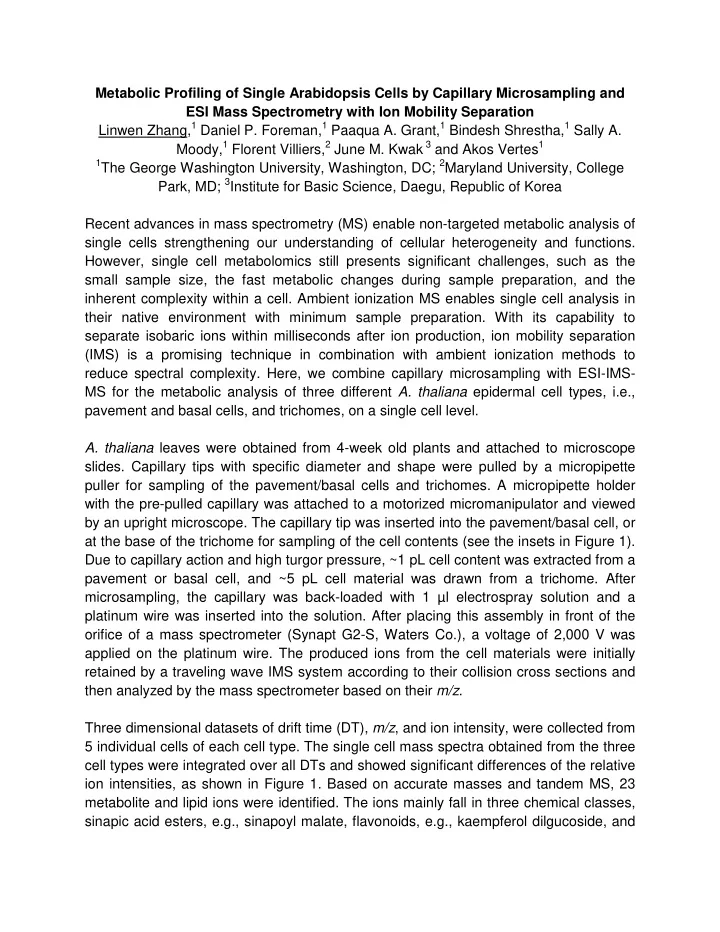

Metabolic Profiling of Single Arabidopsis Cells by Capillary Microsampling and ESI Mass Spectrometry with Ion Mobility Separation Linwen Zhang, 1 Daniel P. Foreman, 1 Paaqua A. Grant, 1 Bindesh Shrestha, 1 Sally A. Moody, 1 Florent Villiers, 2 June M. Kwak 3 and Akos Vertes 1 1 The George Washington University, Washington, DC; 2 Maryland University, College Park, MD; 3 Institute for Basic Science, Daegu, Republic of Korea Recent advances in mass spectrometry (MS) enable non-targeted metabolic analysis of single cells strengthening our understanding of cellular heterogeneity and functions. However, single cell metabolomics still presents significant challenges, such as the small sample size, the fast metabolic changes during sample preparation, and the inherent complexity within a cell. Ambient ionization MS enables single cell analysis in their native environment with minimum sample preparation. With its capability to separate isobaric ions within milliseconds after ion production, ion mobility separation (IMS) is a promising technique in combination with ambient ionization methods to reduce spectral complexity. Here, we combine capillary microsampling with ESI-IMS- MS for the metabolic analysis of three different A. thaliana epidermal cell types, i.e., pavement and basal cells, and trichomes, on a single cell level. A. thaliana leaves were obtained from 4-week old plants and attached to microscope slides. Capillary tips with specific diameter and shape were pulled by a micropipette puller for sampling of the pavement/basal cells and trichomes. A micropipette holder with the pre-pulled capillary was attached to a motorized micromanipulator and viewed by an upright microscope. The capillary tip was inserted into the pavement/basal cell, or at the base of the trichome for sampling of the cell contents (see the insets in Figure 1). Due to capillary action and high turgor pressure, ~1 pL cell content was extracted from a pavement or basal cell, and ~5 pL cell material was drawn from a trichome. After microsampling, the capillary was back-loaded with 1 µl electrospray solution and a platinum wire was inserted into the solution. After placing this assembly in front of the orifice of a mass spectrometer (Synapt G2-S, Waters Co.), a voltage of 2,000 V was applied on the platinum wire. The produced ions from the cell materials were initially retained by a traveling wave IMS system according to their collision cross sections and then analyzed by the mass spectrometer based on their m/z . Three dimensional datasets of drift time (DT), m/z , and ion intensity, were collected from 5 individual cells of each cell type. The single cell mass spectra obtained from the three cell types were integrated over all DTs and showed significant differences of the relative ion intensities, as shown in Figure 1. Based on accurate masses and tandem MS, 23 metabolite and lipid ions were identified. The ions mainly fall in three chemical classes, sinapic acid esters, e.g., sinapoyl malate, flavonoids, e.g., kaempferol dilgucoside, and
phosphatidylcholine lipids (PC), e.g., PC (34:2). By comparison of the normalized intensities of the identified ions, we found that the compound class of sinapic acid esters, such as sinapoyl malate and sinapoyl glucose, exhibited highest abundances in pavement cells, followed by basal cells and was lowest in trichomes. The relative abundances of the flavonoid ions, such as kaempferol glucoside-rhamnoside- rhamnoside, were lowest in pavement cells, followed by basal cells, and showed the highest intensities in trichomes. Most of the identified metabolites were located in the phenylpropanoid biosynthesis pathways. Its subpathway, the sinapic acid ester biosynthesis, showed higher abundances in pavement and basal cells, whereas compounds from the kaempferol glycoside biosynthesis pathway exhibited significantly higher levels in trichomes. These secondary metabolites are precursors to compounds that protect the plant from UV light and pathogens, functions associated with epidermal cells. In addition, we found that IMS enabled the distinction of isobaric ions or close to isobaric ions according to their collision cross sections and enhanced the molecular coverage in a cell. Figure 2 shows the DT vs. m/z plot of a single pavement cell with the detected ions labeled by blue dots. In the plot, ~400 ions were detected from the cell contents, showing a significant improvement over the ~200 ions found in the corresponding mass spectrum. In the m/z 750-800 range in the plot, nine phosphatidylcholine peaks, shown in a red frame, and two kaempferol triglycoside ions, shown in a yellow frame, are differentiated in different DT ranges. The mass spectrum integrated over all the DTs, shown in a black frame, is dominated by kaempferol triglycosides and the signal-to-noise ratio is low. Both of these two groups of chemicals were identified by tandem MS. The results indicated that IMS enhanced the dynamic range of MS analysis of the microsampled cell contents and facilitated the assignment of the detected ions in single cells. Our experiments demonstrated that capillary microsampling coupled with ESI-IMS-MS enabled the metabolic analysis of single A. thaliana epidermal cell types, i.e., pavement and basal cells, and trichomes. Single cell analysis is significantly enhanced by the introduction of IMS in combination with ambient MS. This technique has the potential for subcellular analysis, and tracking metabolic changes in single cells exposed to stress.
Figure 1. Mass spectra of single A. thaliana Figure 2. DT vs. m/z plot of a single pavement epidermal cells: (a) pavement cell, (b) basal cell cell. In the m/z 750-800 range, the mass spectra and (c) trichome, shows distinct differences of the integrated over DT = 0-3.5 ms, DT = 2.3-3.5 ms, relative ion abundances from the three cell types. and DT = 2.5-2.7 ms are shown with black, The insets show the microscope images of the yellow, and red frames, respectively. Compound corresponding cell types during capillary classes of phosphatidylcholines and kaempferol microsampling. triglycosides are distinguished by their drift times.
Recommend
More recommend